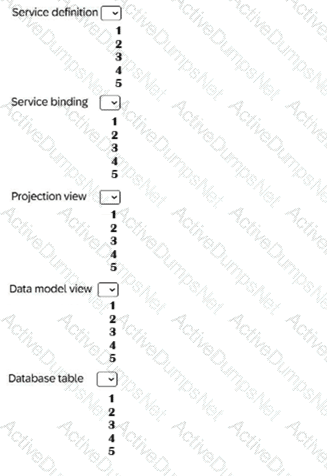Which models must you use to develop artifacts that expose ABAP-based backend services based on semantic data models? (Select 2)
Which of the following integration frameworks have been released for ABAP Cloud development? (Select 3)
Which of the following are reasons that SAP recommends developing Core Data Services view entities as opposed to classic Core Data Services DDIC-based views?
Note: There are 2 correct answers to this question.
Which of the following ABAP SQL aggregate functions accept an ABAP SQL expression (e.g., f1 + f2) as input?
(Select 2 correct answers)
Setting a field to read-only in which object would make the field read-only in all applications of the RAP model?
When you join two database tables, which of the following rules applies to the database fields you use in the join?
Which of the following custom code use cases falls under Tier 1 extensibility guidelines?
In what order are objects created to generate a RESTful Application Programming application?

Given the following Core Data Service View Entity Data Definition:
@AccessControl.authorizationCheck: #NOT_REQUIRED
DEFINE VIEW ENTITY demo_flight_info_union AS
SELECT FROM scustom {
KEY id,
KEY 'Customer' AS partner,
name,
city,
country
}
UNION
SELECT FROM stravelag {
KEY agencynum AS id,
'Agency' AS partner,
name,
city,
country
}
When you attempt to activate the definition, what will be the response?
When defining a METHOD, which parameter type can only have 1 value?
Given the following ABAP SQL statement excerpt from an ABAP program:
SELECT SINGLE *
FROM spfli
WHERE carrid = 'LH' AND connid = '0400'
INTO @DATA(wa).
You are given the following information:
The data source spfli on line #2 is an SAP HANA database table.
spfli will be a large table with over one million rows.
This program is the only one in the system that accesses the table.
This program will run rarely.
Based on this information, which of the following general settings should you set for the spfli database table?
Note: There are 2 correct answers to this question.
What RESTful Application Programming feature is used to ensure the uniqueness of a semantic key?
Which of the following types of Core Data Services Views can be used at the consumption layer?
Note: There are 3 correct answers to this question.
Which of the following actions cause an indirect change to a database table requiring a table conversion? (Select 2)
Which of the following are valid ABAP SQL type conversions? (Select 3 correct answers)
Given the following Core Data Services (CDS) View Entity data definition:
DEFINE VIEW ENTITY demo_cds_view_entity
AS SELECT FROM spfli
{
cityfrom,
cityto,
carrid,
connid
}
When you attempt to activate the definition, what will be the response?
Which of the following pre-defined ABAP data types is a complete data type?
In a CDS view, where can a value help be defined?
How do you make class sub1 a subclass of class super1?
In a class you use the statement DATA var TYPE …
What may stand in place of the type?
(Select 2 correct answers)
What can you do in SAP S/4HANA Cloud, public edition? (2 correct)
What RAP object contains only the fields required for a particular app?
Which of the following are rules that extensions in SAP S/4HANA Cloud, public edition must adhere to? (Select 3 correct answers)
You have attached a system field to an input parameter of a CDS view entity as follows:
define view entity Z_ENTITY
with parameters
@Environment.systemField: #SYSTEM_LANGUAGE
language : spras
What are the effects of this annotation? (Select 2 correct answers)